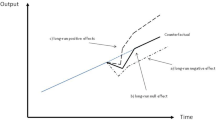Abstract
This paper examines the impact of floods on the firms’ capital accumulation, employment growth and productivity by using a difference-in-difference (DID) approach and considering the firms’ asset structure. We find evidence that, in the short run, companies in regions hit by a flood show on average higher growth of total assets and employment than firms in regions unaffected by flooding. The positive effect prevails for companies with larger shares of intangible assets. Regarding the firms’ productivity a negative flood effect is observable which declines with an increasing share of intangible assets.
Similar content being viewed by others
References
Albala-Bertrand JM (1993) Natural disaster situations and growth: a macroeconomic model for sudden disaster impacts. World Dev 21(9): 1417–1434
Anbarci N, Escaleras M, Register CA (2005) Earthquake fatalities: the interaction of nature and political economy. J Public Econ 89(9–10): 1907–1933
Bloningen BA, Tomlin K (2001) Size and growth of Japanese plantes in the United States. Int J Ind Org 19(6): 931–952
Cabral LMB, Mata J (2003) On the evolution of the firm size distribution: facts and theory. American Economic Review 93(4): 1075–1090
Center for Research on the Epidemiology of Disasters (CRED) (2007) International disaster database. http://www.emdat.net—Universite Catholique de Louvain, Brussels
Christensen JH, Christensen OB (2002) Severe summertime flooding in Europe. Nature 421: 805–806
Crespo-Cuaresma J, Hlouskova J, Obersteiner M (2008) Natural disasters as creative destruction? evidence from developing countries. Econ Inq 46(2): 214–226
Evans DS (1982) Tests of alternative theories of firm growth. J Pol Econ 95(4): 657–674
Ewing BT, Kruse JB, Thompson MA (2003) A comparison of employment growth and stability before and after the fort worth tornado. Environ Hazards 5: 83–91
Ewing BT, Kruse JB, Thompson MA (2007) Twister! employment responses to the 3 May 1999 Oklahoma City Tornado. Appl Econ 1–12 (forthcoming)
Federal Emergency Management Agency (FEMA) (2004) Using HAZUS-MH for risk assessment. http://wwwfemagov/library/viewRecorddo?id=1985
Fotopoulus G, Louri H (2004) Firm growth and FDI: are multinationals stimulating local industry development?. J Ind Compet Trade 4(3): 163–189
Gibrat R (1931) Les Inequalities Economiques. Sirey, Paris
Hallegatte S, Hourcade JC, Dumas P (2007) Why economic dynamics matter in assessing climate change damages: illustration on extreme events. Ecol Econ 62: 330–340
Halliday T (2006) Migration, risk, and liquidity constraints in El Salvador. Econ Dev Cult Chang 54(4): 893–925
Kahn ME (2005) The death toll from natural disasters: the role of income, geography and institutions. Rev Econ Stat 87(2): 271–284
Levinsohn J, Petrin A (2003) Estimating production functions using inputs to control for unobservables. Rev Econ Stud 70(2): 317–341
Llasat MDC, Rigo T, Barriendos M (2003) The Montserrat-2000 flash-flood event: a comparison with the floods that have occurred in the northeastern Iberian peninsula since the 14th Century. Int J Climatol 23: 453–469
Murlidharan TL (2003) Economic consequences of catastrophes triggered by natural hazards. PhD thesis, The John A. Blume Earthquake Engineering Center, Department of Civil and Environmental Engineering, Stanford University, Stanford
Okuyama Y (2003) Economics of natural disasters: a critical review. Mimeo Regional Research Institute, West Virginia University
Olley S, Pakes A (1996) The dynamics of productivity in the telecommunications equipment market. Econometrica 64(6): 1263–1298
Parry ML, Canziani OF, Palutikof JP, van der Linden PJ, Hanson CE (2007) Climate change 2007: Impacts, adaption and vulnerability. Contribution of working group II to the fourth assessment report of the intergovernmental panel on climate change (IPCC). Cambridge University Press, New York
Raschky PA (2007) Estimating the effects of risk transfer mechanisms against floods in Europe and USA: a dynamic panel approach. Working papers in economics and statistics No 2007-05, University of Innsbruck
Risk Management Solutions (RMS) (2000a) UK Floods, Oct 2000. Catastrophe Event Report
Risk Management Solutions (RMS) (2000b) UK Floods, Nov 2000. Catastrophe Event Report
Rose A (2004) Economic principles, issues, and research priorities in hazard loss estimation. In: Okuyama Y, Chang SE (eds) Modeling spatial and economic impacts of disasters. Springer-Verlag, Berlin, pp 13–36
Rose A, Liao SY (2005) Modeling regional economic resilience to disasters: a computable general equilibrium analysis of water service disruptions. J Reg Sci 45(1): 75–112
Rose A, Benavides J, Chang SE, Szczesniak P, Lim D (1997) The regional economic impact of an earthquake: direct and indirect effects of electricity lifeline disruptions. J Reg Sci 37(3): 437–458
Schröter D, Cramer W, Leemans R, Prentice IC, Araujo MB, Arnell NW, Bondeau A, Bugmann H, Carter TR, Gracia CA, de la Vega-Leinert AC, Erhard M, Ewert F, Glendining M, House IH Joanna, Kankaanpää S, Klein RJT, Lavorel S, Lindner M, Metzger MJ, Meyer J, Mitchell TD, Reginster I, Rounsevell M, Sabaté S, Sitch S, Smith B, Smith J, Smith P, Sykes MT, Thonicke K, Thuiller W, Tuck G, Zaehle S, Zierl B (2005) Ecosystem service supply and vulnerability to global change in Europe. Science 310: 1333–1337
Shughart WF (2006) Katrinanomics: the politics and economics of disaster relief. Public Choice 127(1–2): 31–53
Skidmore M, Toya H (2002) Do natural disasters promote long-run growth?. Econ Inq 40(4): 664–687
Sobel RS, Leeson PT (2006) Government’s response to hurricane katrina: a public choice analysis. Public Choice 127(1-2): 55–73
Sutton J (1997) Gibrat’s legacy. J Econ Lit 35(1): 40–59
Tol RSJ, Leek FPM (1999) Economic analysis of natural disasters. In: Downing TE, Olsthoorn AA, Tol RSJ (eds) Climate, change and risk. Routledge, London, pp 308–327
Wooldridge JM (2002) Econometric analysis of cross section and panel data. MIT-Press, Cambridge and London
Author information
Authors and Affiliations
Corresponding author
Rights and permissions
About this article
Cite this article
Leiter, A.M., Oberhofer, H. & Raschky, P.A. Creative Disasters? Flooding Effects on Capital, Labour and Productivity Within European Firms. Environ Resource Econ 43, 333–350 (2009). https://doi.org/10.1007/s10640-009-9273-9
Received:
Accepted:
Published:
Issue Date:
DOI: https://doi.org/10.1007/s10640-009-9273-9




